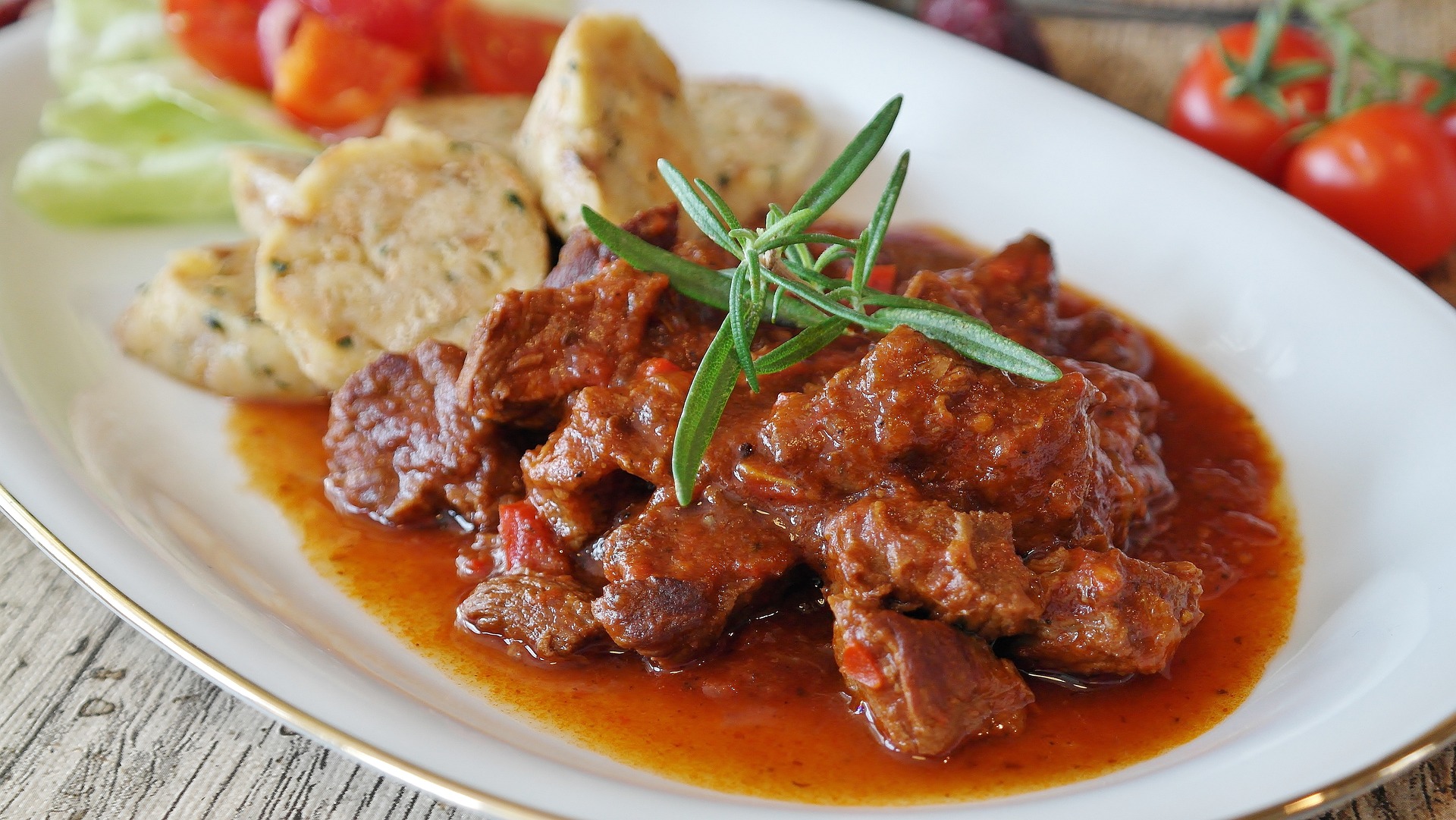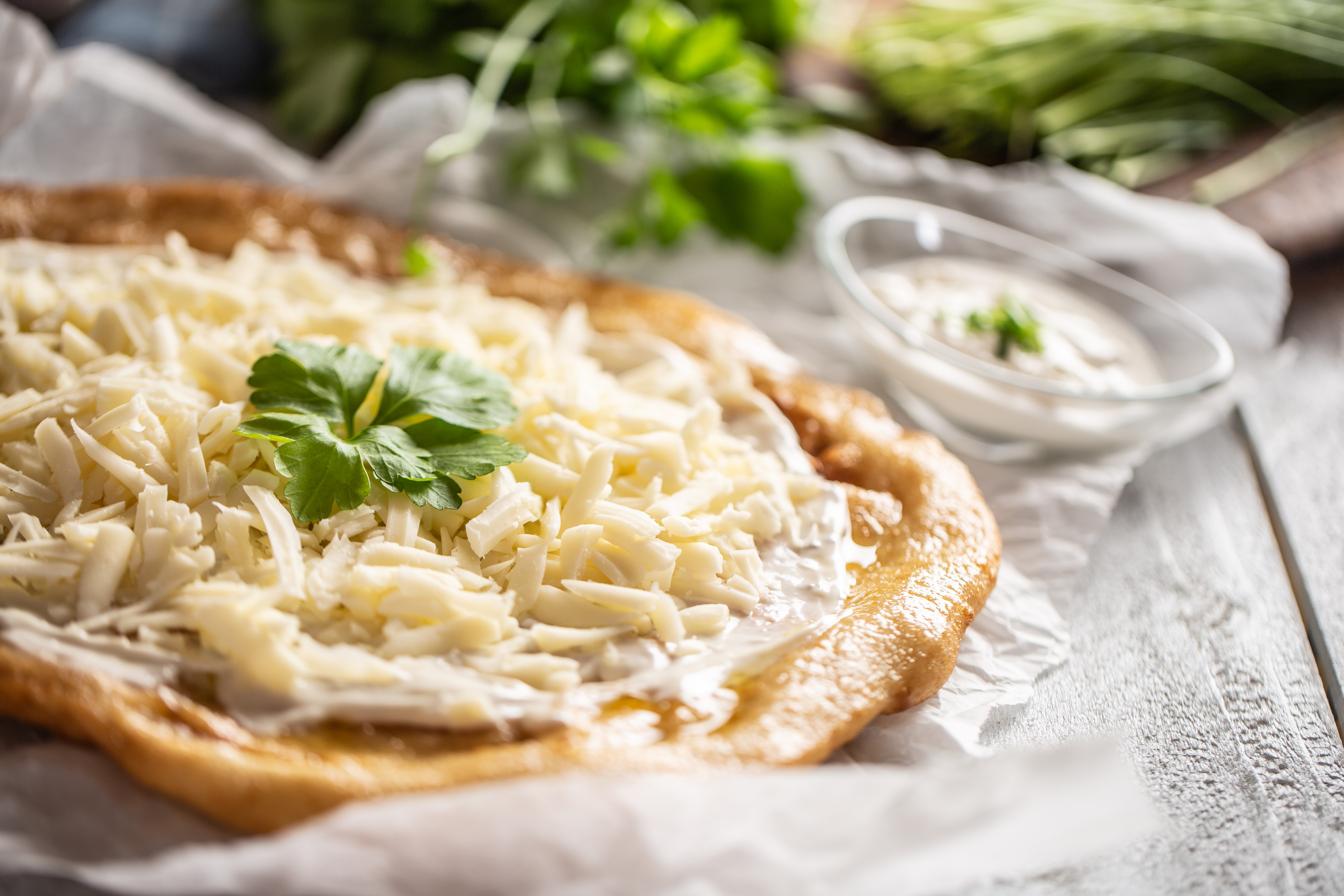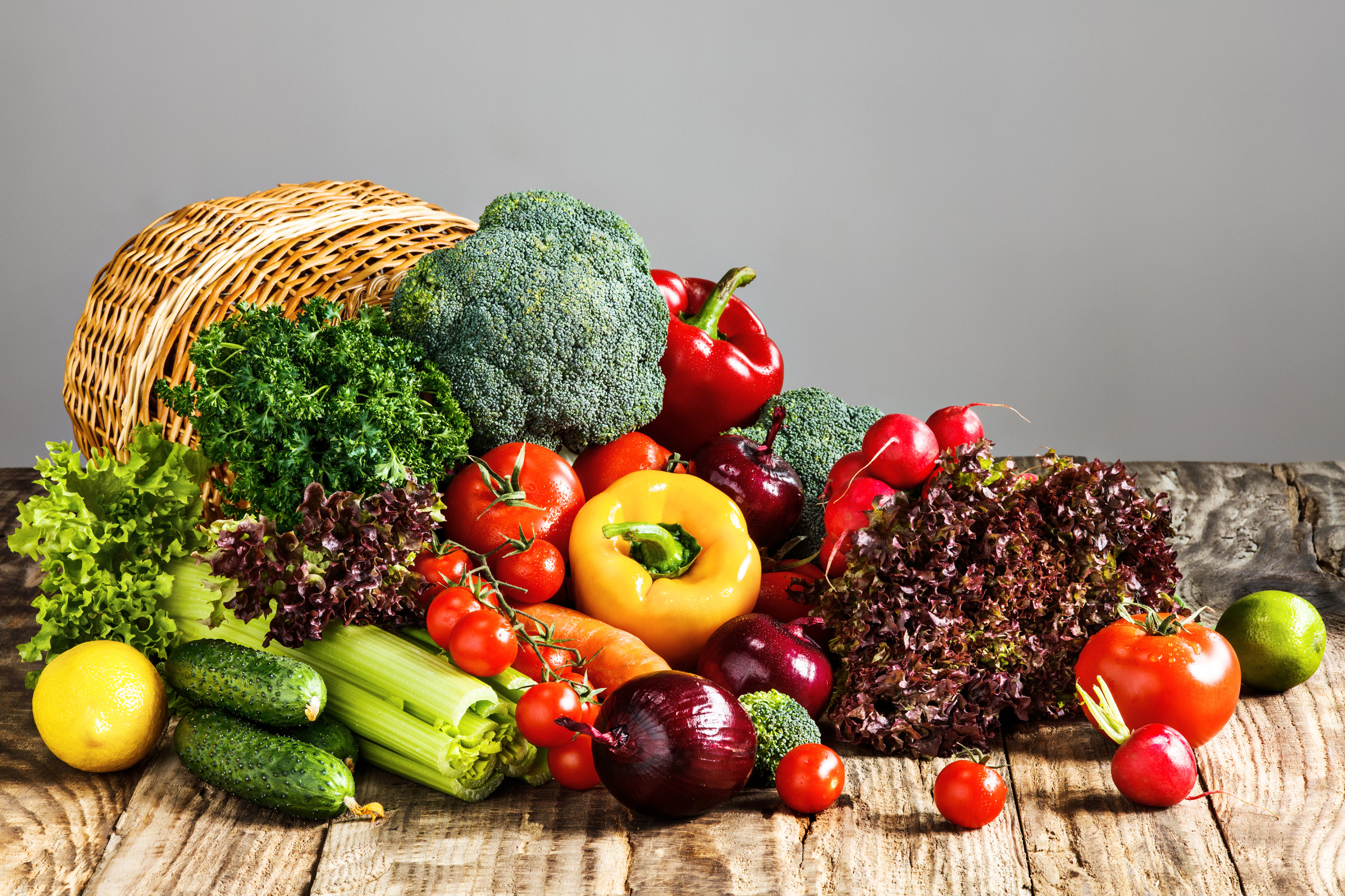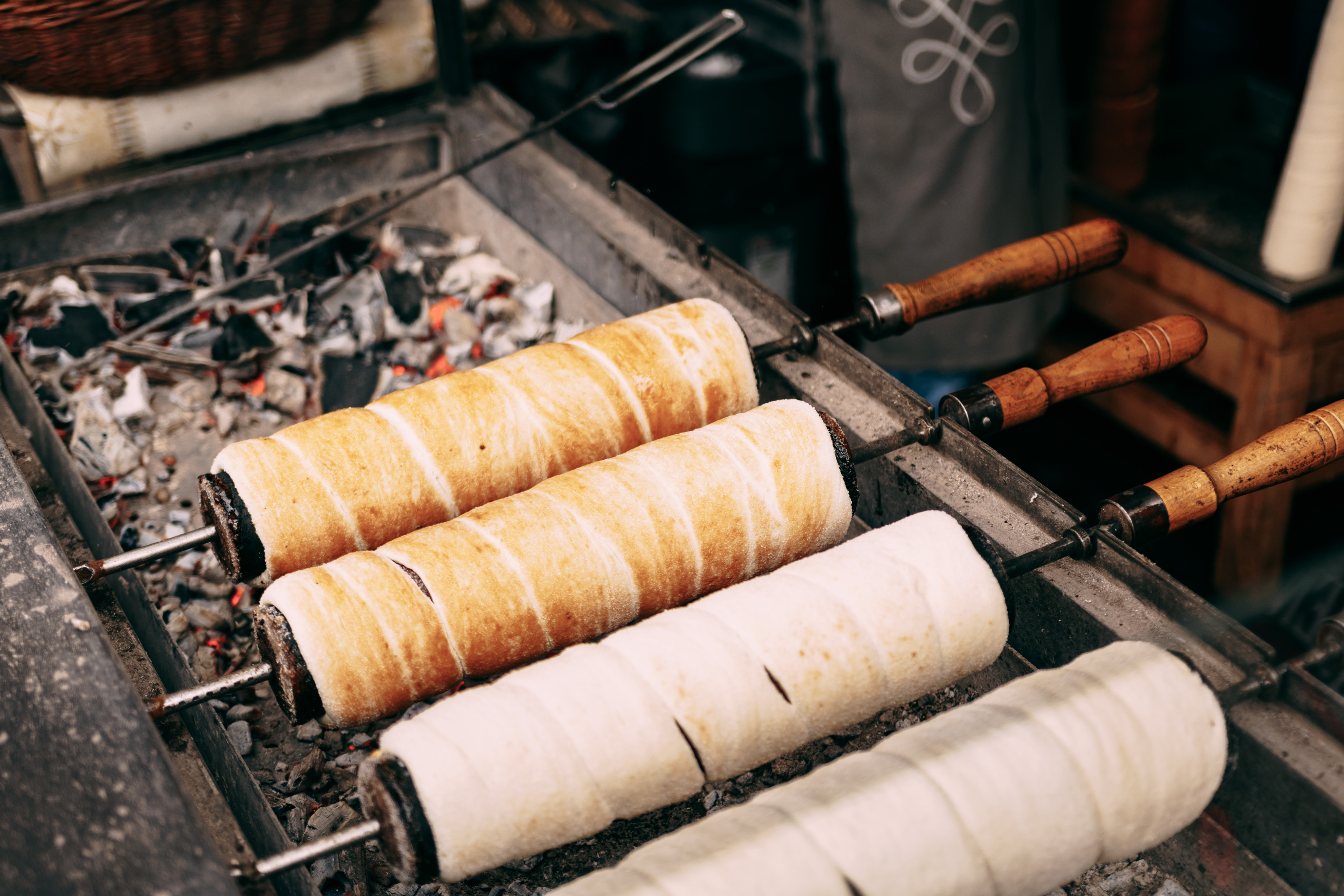Budapest is an exciting tourist destination known for its fabulous architecture, classical ‘European city’ atmosphere, and all sorts of fascinating places to visit. With delights galore, it might be easy to overlook the array of mouth-watering traditional dishes that Budapest has on the menu.
We’ve picked a selection that you certainly won’t want to miss out on during your visit. Enhance your stay with one of our local Budapest private tour guides who can make sure you see everything on your list while directing you to the best places to enjoy every local delicacy.
Gulyás
 Gulyás or ‘goulash’ as it is known in English, is Hungary’s national dish. Served as a stew in most parts of the world, Hungarian goulash is actually a thin broth with chunks of beef, onions, tomatoes, pepper, paprika, and seasoning. Potatoes can also be added, and sometimes pork or mutton is substituted for beef. Some variations also include csipetke, a pinched pasta.
Gulyás or ‘goulash’ as it is known in English, is Hungary’s national dish. Served as a stew in most parts of the world, Hungarian goulash is actually a thin broth with chunks of beef, onions, tomatoes, pepper, paprika, and seasoning. Potatoes can also be added, and sometimes pork or mutton is substituted for beef. Some variations also include csipetke, a pinched pasta.
The dish was originally prepared by cattle herders who fried up pork fat and onions over a campfire and added chopped beef. The food was cooked in a cast iron cauldron over an open fire, and many traditional restaurants still cook it this way.
Goulash is usually served with hot paprika and sliced white bread or nokedli - Hungarian dumplings. It’s a hearty dish that is enjoyed by locals during both the summer and winter months. Naturally, there are many highly rated restaurants around Budapest serving goulash, such as Baltazar Budapest, Nancsi Neni, or Stand25 Bisztro in the Hold Street Market. You can also ask your local Budapest tour guide to show you to their favorite goulash spots.
Lángos
 Lángos (pronounced lung-osh in English), is a bubbly, deep-fried flat bread made of flour, yeast, water, and salt. It is enjoyed best when crispy on the outside but still soft on the inside. It is said that lángos was first created when some bakers grew hungry while waiting for the bread to rise, so they removed it from the oven early for a snack.
Lángos (pronounced lung-osh in English), is a bubbly, deep-fried flat bread made of flour, yeast, water, and salt. It is enjoyed best when crispy on the outside but still soft on the inside. It is said that lángos was first created when some bakers grew hungry while waiting for the bread to rise, so they removed it from the oven early for a snack.
One of Budapest’s most popular street foods, lángos is fried in oil and usually eaten warm with garlic, grated cheese, and sour cream slathered on top. Alternative toppings include sausage, ham, and goat cheese. There are also sweet lángos variations with jam or Nutella, but these are not the typical way Hungarians enjoy them.
This classic comfort food can be found at various markets, metro stations, or local fast food chains such as Retro Bufe which has locations throughout the city. It’s a savory treat to eat on the go and can be enjoyed year round.
Rakott krumpli
 This dish is the Hungarian version of potato gratin. Prepared with layers of sliced potatoes, hard-boiled eggs, sour cream, salt and pepper, and sometimes paprika-flavored smoked sausage. The name translates to English as pleated or layered potatoes. It’s a dish that can be found both in private kitchens and restaurants.
This dish is the Hungarian version of potato gratin. Prepared with layers of sliced potatoes, hard-boiled eggs, sour cream, salt and pepper, and sometimes paprika-flavored smoked sausage. The name translates to English as pleated or layered potatoes. It’s a dish that can be found both in private kitchens and restaurants.
The first time a recipe for rakott krumpli appeared in print was in a Hungarian cookbook published in 1840. The dish was not common at restaurants in the past; however recently it has been gaining in popularity. It can be eaten as a main dish with pickles on the side or served as a side dish. Stand 25 at the Hold Street Market Hall is a recommended place to try this Hungarian classic.
Töltött káposzta
 Having once been part of the Ottoman Empire, it's no surprise to find that Hungary has adopted some Ottoman dishes and made them their own. Stuffed cabbage Hungarian style is prepared with seasoned minced pork, rice, chopped onions, egg, and sometimes tomato - all wrapped in a cabbage leaf, seasoned with paprika, and placed upon a layer of sauerkraut. Slices of smoked bacon are added, and then more sauerkraut is spooned on top. Finally, a layer of cabbage tops it off. It's covered with water and brought to a boil, then left to simmer until the contents are all cooked through.
Having once been part of the Ottoman Empire, it's no surprise to find that Hungary has adopted some Ottoman dishes and made them their own. Stuffed cabbage Hungarian style is prepared with seasoned minced pork, rice, chopped onions, egg, and sometimes tomato - all wrapped in a cabbage leaf, seasoned with paprika, and placed upon a layer of sauerkraut. Slices of smoked bacon are added, and then more sauerkraut is spooned on top. Finally, a layer of cabbage tops it off. It's covered with water and brought to a boil, then left to simmer until the contents are all cooked through.
Töltött káposzta is most commonly enjoyed in winter, and as you can tell from the long list of ingredients, things can get quite complex. That’s why this is definitely a dish worth trying at an established local restaurant. To make things easy, ask one of our Hungarian tour guides to show you around the most popular places.
Lecsó
 Lecsó is a versatile dish made primarily with sweet yellow peppers and tomatoes. It is prepared by sauteing the peppers and some onions in pork fat before adding the tomatoes. To make it more filling, some variations can also include sausages, eggs, or beans.
Lecsó is a versatile dish made primarily with sweet yellow peppers and tomatoes. It is prepared by sauteing the peppers and some onions in pork fat before adding the tomatoes. To make it more filling, some variations can also include sausages, eggs, or beans.
This colorful winter comfort food can be eaten with a helping of sour cream, together with smoked meat roasts, or served as a side dish to túrós csusza (pasta and cottage cheese). It can also be used as a topping for eggs or a slice of bread.
Hungarians who prepare lecsó at home often make it in large quantities when the vegetables are at the peak of ripeness. It is then canned and stored to last through the cold winter months. When in season, lecsó can be found almost everywhere. Look for it at Borkonyha Winekitchen or at Café Kör Restaurant located near the Basilica.
Főzelék
 A famous dish served in canteens, főzelék is made of whatever vegetables are available. The most common ingredients include bell peppers, tomatoes, cabbage, beans, peas, carrots, and squash. For extra flavor, bay leaves, garlic, dill, caraway seeds, and of course paprika can be added.
A famous dish served in canteens, főzelék is made of whatever vegetables are available. The most common ingredients include bell peppers, tomatoes, cabbage, beans, peas, carrots, and squash. For extra flavor, bay leaves, garlic, dill, caraway seeds, and of course paprika can be added.
The ingredients are cooked in lard and thickened with flour. The resulting concoction is somewhere between a soup and a stew, and like so many Hungarian dishes it is often served with sour cream. Főzelék can make for a great traditional option for those in search of vegetarian dishes.
Paprikás csirke
 Chicken paprikash, as the name translates, is quite possibly the number two traditional dish in Hungary after goulash. It even got mentioned in Bram Stoker's Dracula. It is tender chicken and a thick sauce made with paprika and sour cream (yes, again).
Chicken paprikash, as the name translates, is quite possibly the number two traditional dish in Hungary after goulash. It even got mentioned in Bram Stoker's Dracula. It is tender chicken and a thick sauce made with paprika and sour cream (yes, again).
It is usually served with nokedli (Hungarian dumplings) or a homemade pasta called galuska. This simple dish can have a surprisingly rich flavor profile, making it popular with home cooks and professional chefs alike.
Kürtőskalács
 What list of local delectables would be complete without something sweet? "Chimney cake" is a cylindrical cake that is served while still hot so that the rising steam resembles smoke from a chimney. It is prepared by winding strips of a sweet yeast dough around a truncated cylindrical spit, and then coated in melted butter and rolled in cinnamon and icing sugar. As the cake is roasted over charcoal, the sugar forms a unique crispy coating. Once ready, the cake is carefully slid off the spit and then sprinkled with cinnamon or ground walnuts. It is intended to be shared, and is eaten by tearing off strips of the hot, sweet, crunchy dough.
What list of local delectables would be complete without something sweet? "Chimney cake" is a cylindrical cake that is served while still hot so that the rising steam resembles smoke from a chimney. It is prepared by winding strips of a sweet yeast dough around a truncated cylindrical spit, and then coated in melted butter and rolled in cinnamon and icing sugar. As the cake is roasted over charcoal, the sugar forms a unique crispy coating. Once ready, the cake is carefully slid off the spit and then sprinkled with cinnamon or ground walnuts. It is intended to be shared, and is eaten by tearing off strips of the hot, sweet, crunchy dough.
Chimney cakes are mostly popular around the Christmas season, but they can typically be found at markets and roadside kiosks throughout the city all year round. A good place to find chimney cake is at the Central Market Hall. Just remember, Chimney cake is best enjoyed when it is still steaming fresh.
Conclusion
Part of the excitement of visiting Budapest lies in trying out some of the region’s historical cuisine. Touring the city will surely whet your appetite for something savory, and Hungarian cooking has much to tantalize your taste buds (especially if you love sour cream). Start planning a Budapest tour with the help of your personal Hungarian tour guide. They can help you find the best places to indulge in the local delicacies.